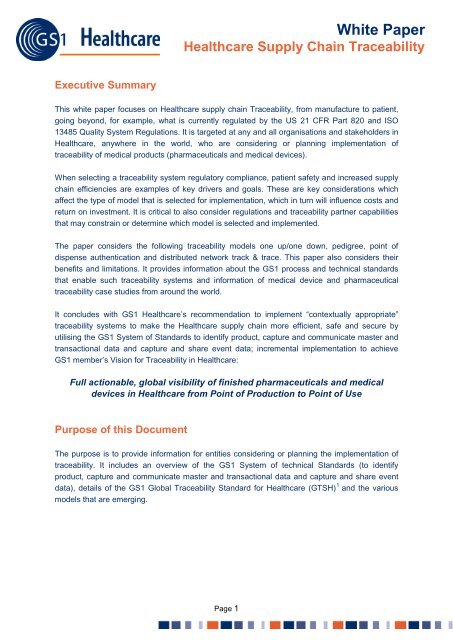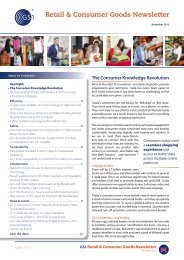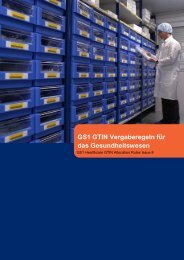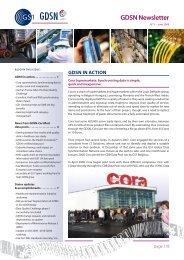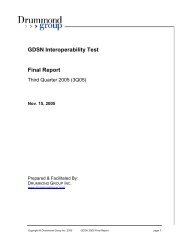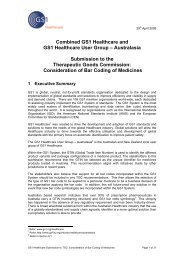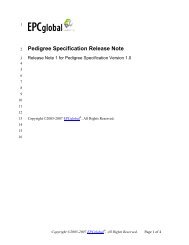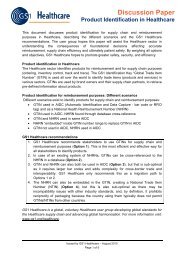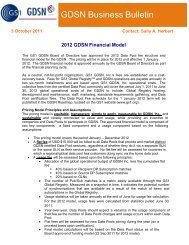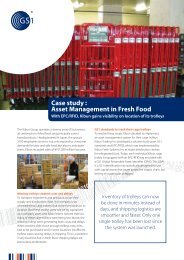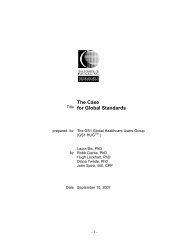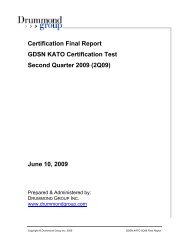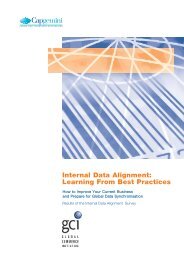Healthcare Supply Chain Traceability (White Paper) - GS1
Healthcare Supply Chain Traceability (White Paper) - GS1
Healthcare Supply Chain Traceability (White Paper) - GS1
You also want an ePaper? Increase the reach of your titles
YUMPU automatically turns print PDFs into web optimized ePapers that Google loves.
<strong>White</strong> <strong>Paper</strong><br />
<strong>Healthcare</strong> <strong>Supply</strong> <strong>Chain</strong> <strong>Traceability</strong><br />
Executive Summary<br />
This white paper focuses on <strong>Healthcare</strong> supply chain <strong>Traceability</strong>, from manufacture to patient,<br />
going beyond, for example, what is currently regulated by the US 21 CFR Part 820 and ISO<br />
13485 Quality System Regulations. It is targeted at any and all organisations and stakeholders in<br />
<strong>Healthcare</strong>, anywhere in the world, who are considering or planning implementation of<br />
traceability of medical products (pharmaceuticals and medical devices).<br />
When selecting a traceability system regulatory compliance, patient safety and increased supply<br />
chain efficiencies are examples of key drivers and goals. These are key considerations which<br />
affect the type of model that is selected for implementation, which in turn will influence costs and<br />
return on investment. It is critical to also consider regulations and traceability partner capabilities<br />
that may constrain or determine which model is selected and implemented.<br />
The paper considers the following traceability models one up/one down, pedigree, point of<br />
dispense authentication and distributed network track & trace. This paper also considers their<br />
benefits and limitations. It provides information about the <strong>GS1</strong> process and technical standards<br />
that enable such traceability systems and information of medical device and pharmaceutical<br />
traceability case studies from around the world.<br />
It concludes with <strong>GS1</strong> <strong>Healthcare</strong>’s recommendation to implement “contextually appropriate”<br />
traceability systems to make the <strong>Healthcare</strong> supply chain more efficient, safe and secure by<br />
utilising the <strong>GS1</strong> System of Standards to identify product, capture and communicate master and<br />
transactional data and capture and share event data; incremental implementation to achieve<br />
<strong>GS1</strong> member’s Vision for <strong>Traceability</strong> in <strong>Healthcare</strong>:<br />
Full actionable, global visibility of finished pharmaceuticals and medical<br />
devices in <strong>Healthcare</strong> from Point of Production to Point of Use<br />
Purpose of this Document<br />
The purpose is to provide information for entities considering or planning the implementation of<br />
traceability. It includes an overview of the <strong>GS1</strong> System of technical Standards (to identify<br />
product, capture and communicate master and transactional data and capture and share event<br />
data), details of the <strong>GS1</strong> Global <strong>Traceability</strong> Standard for <strong>Healthcare</strong> (GTSH) 1 and the various<br />
models that are emerging.<br />
Page 1
<strong>White</strong> <strong>Paper</strong><br />
<strong>Healthcare</strong> <strong>Supply</strong> <strong>Chain</strong> <strong>Traceability</strong><br />
<strong>GS1</strong> Standards for <strong>Traceability</strong><br />
There are a number of factors that determine the operational context for all organisations, such<br />
as the operational and market situation and regulations. In turn the operational context will<br />
determine which traceability model is appropriate, i.e. a “contextually appropriate” model.<br />
Key to the incremental implementation of a contextually appropriate traceability system is the<br />
availability of <strong>GS1</strong> process and technical standards. The ratified standards are available from the<br />
<strong>GS1</strong> <strong>Healthcare</strong> website: http://www.gs1.org/<strong>Healthcare</strong>/standards.<br />
Process Standard<br />
• The <strong>GS1</strong> Global <strong>Traceability</strong> Standard for <strong>Healthcare</strong><br />
The core process standard is the <strong>GS1</strong> Global <strong>Traceability</strong> Standard for <strong>Healthcare</strong><br />
(GTSH). It defines <strong>Traceability</strong> as “…the ability to track forward the movement through<br />
specified stage(s) of the extended supply chain and trace backward the history,<br />
application or location of that which is under consideration”. It is complemented by the<br />
GTSH Implementation Guide 2 .<br />
Technical Standards<br />
• Auto-Identification & Data Capture (AIDC) Application Standards<br />
<strong>GS1</strong> Identification Keys: numbering schemas for products, locations, patients, caregivers,<br />
and assets. <strong>GS1</strong> Barcodes: several types of bar code, linear and 2-dimensional (2D) and<br />
Radio Frequency Identification (RFID) tags for use by <strong>GS1</strong> members depending on the<br />
application. GTIN Allocation Rules for <strong>Healthcare</strong>: GTIN (Global Trade Item Number)<br />
provides unique identification for <strong>Healthcare</strong> Items.<br />
• Global Data Synchronisation Network (GDSN) for <strong>Healthcare</strong> Standard<br />
The GDSN enables continuous and secure global product data synchronisation and<br />
accurate product data across supply chain partners and is built around the <strong>GS1</strong> Global<br />
Registry®, GDSN-certified data pools; the <strong>GS1</strong> Data Quality Framework and <strong>GS1</strong> Global<br />
Product Classification.<br />
• eCOM business-to-business messaging standards<br />
<strong>GS1</strong> eCom provides global standards for electronic business messaging that allow rapid,<br />
efficient and accurate automatic electronic transmission of agreed business data<br />
between trading partners in the form of EANCOM or <strong>GS1</strong> XML messages.<br />
• EPCglobal Visibility standards<br />
EPCglobal supports increased visibility and efficiency throughout the supply chain and<br />
higher quality information flow between organisations and their key trading partners. This<br />
is achieved through data standards and interface standards.<br />
The <strong>GS1</strong> System of Standards continues to develop as necessary to meet the evolution of<br />
<strong>Healthcare</strong> traceability requirements.<br />
Page 2
<strong>White</strong> <strong>Paper</strong><br />
<strong>Healthcare</strong> <strong>Supply</strong> <strong>Chain</strong> <strong>Traceability</strong><br />
<strong>GS1</strong> Standards at Work in the <strong>Healthcare</strong> <strong>Supply</strong> <strong>Chain</strong><br />
Figure 1 below shows the suite of <strong>GS1</strong> Standards as they apply across the <strong>Healthcare</strong> supply<br />
chain from manufacture to <strong>Healthcare</strong> provider and how they enable traceability.<br />
Figure 1: <strong>GS1</strong> Standards at Work in the <strong>Healthcare</strong> <strong>Supply</strong> <strong>Chain</strong><br />
Page 3
<strong>White</strong> <strong>Paper</strong><br />
<strong>Healthcare</strong> <strong>Supply</strong> <strong>Chain</strong> <strong>Traceability</strong><br />
<strong>Traceability</strong> Models<br />
There are currently a number of emerging models for traceability: e.g. one up/one down,<br />
pedigree, point of dispense authentication, and distributed network track & trace. There are key<br />
operational and market factors which affect the type of model that is selected, which in turn will<br />
influence costs and return on investment. It is critical to also consider regulations that may<br />
constrain or determine which model is selected and implemented. The context therefore<br />
determines which traceability model is appropriate (i.e. contextually appropriate). Below is a brief<br />
discussion of these emerging models that could be deployed to achieve the incremental<br />
implementation of contextually appropriate traceability systems.<br />
One up, One down<br />
The GTSH establishes the “one up, one down” model as the foundational traceability model. In<br />
this model the product moves from one party (e.g. manufacturer (supplier)) to the next party in<br />
the supply chain (e.g. <strong>Healthcare</strong> provider (buyer)): the manufacturer is “one up” from the<br />
<strong>Healthcare</strong> provider, who is “one down” from the manufacturer. In parallel to the physical flow of<br />
product is the flow of data related to that product, this is recorded and sent by “one up” party to<br />
the “one down” party who also records it. The one up, one down flow may happen multiple times<br />
before the product and data reach the end user/consumer. This model can be represented<br />
graphically as follows (Figure 2).<br />
Figure 2: One up, One down Model<br />
Due to the highly regulated nature of <strong>Healthcare</strong>, this model may already be in place for<br />
numerous stakeholders, but for those who do not have a traceability system in place, it is<br />
suggested that implementation of this foundational model should be the primary objective. It can<br />
then provide the foundation for migration to other, increasingly more sophisticated, models that<br />
are emerging, under pilot or regulated for example:<br />
Page 4
<strong>White</strong> <strong>Paper</strong><br />
<strong>Healthcare</strong> <strong>Supply</strong> <strong>Chain</strong> <strong>Traceability</strong><br />
Pedigree<br />
Pedigree means a record containing information regarding each transaction resulting in a change<br />
of ownership, change of custody or both of a given prescription drug, from sale by a<br />
manufacturer, through acquisition and sale by one or more wholesalers, manufacturers, repackagers,<br />
or pharmacies, until final sale to a pharmacy or other person furnishing,<br />
administering, or dispensing the prescription drug. A pedigree is created in a paper based form<br />
or electronic form (commonly referred to as an e-Pedigree) and should be maintained in an<br />
interoperable system, ensuring compatibility throughout all stages of distribution.<br />
An example of e-Pedigree is the US California legislation 3 scheduled to become effective in<br />
2015.<br />
Point of Dispense Authentication<br />
In general authentication is the process of determining whether someone or something is, in fact,<br />
who or what it is declared to be.<br />
The <strong>GS1</strong> System Architecture provides the mechanism for <strong>Healthcare</strong> stakeholders to<br />
authenticate the <strong>GS1</strong> Product Identifier (e.g. the Global Trade Item Number (GTIN) in the carrier<br />
(bar code or RFID)) through capturing data, transmitting data and communicating the results.<br />
An example of a product identifier authentication pilot is the European Federation of<br />
Pharmaceutical Industries and Associations (EFPIA) Point of Dispense Verification Pilot 4 .<br />
Point of dispense authentication may not be appropriate in some contexts due to, for example,<br />
the <strong>Healthcare</strong> setting (retail vs. <strong>Healthcare</strong> provider) or the type of product (e.g. medical device).<br />
In such situations, a different contextually appropriate model should be adopted.<br />
For example, the current Turkish regulation, aimed at eliminating reimbursement fraud of<br />
pharmaceuticals, requires manufactures to apply a GTIN, lot number, expiry date and serial<br />
number to each sales pack in human readable and 2D barcode form. This information is<br />
uploaded to a central government database. When the product is dispensed at a pharmacy, the<br />
2D barcode will be scanned and the scanned data will be uploaded to the government database<br />
signifying that the product has been dispensed.<br />
The application of <strong>GS1</strong> Product Identifier Authentication can enable the process of package<br />
authentication by manufacturers employing, on genuine products, an identifier in an effort to<br />
protect the product from counterfeiting.<br />
Page 5
<strong>White</strong> <strong>Paper</strong><br />
<strong>Healthcare</strong> <strong>Supply</strong> <strong>Chain</strong> <strong>Traceability</strong><br />
Distributed Network Track & Trace<br />
Looking to the future and to achieve <strong>GS1</strong> member’s Vision for <strong>Traceability</strong> in <strong>Healthcare</strong> (below)<br />
it is likely that a distributed network trace and trace model would be required. In this model<br />
parties who may have regulated, manufactured, bought, sold, distributed, sent, received or<br />
repackaged product publish key data that is accessible by other parties authorised to view the<br />
data in order to, for example, authenticate the product identifier, establish a products pedigree or<br />
locate product for recall. Conceptually Figure 3 represents this model.<br />
Repository(ies) for<br />
Data search<br />
Information<br />
flow<br />
Manufacturer<br />
Distributor<br />
<strong>Healthcare</strong><br />
Provider<br />
Physical<br />
flow<br />
<strong>Traceability</strong><br />
Partner<br />
Manufacturer<br />
Distributor<br />
<strong>Healthcare</strong> Provider<br />
Figure 3: Conceptual Distributed Network Track & Trace Model<br />
Page 6
<strong>White</strong> <strong>Paper</strong><br />
<strong>Healthcare</strong> <strong>Supply</strong> <strong>Chain</strong> <strong>Traceability</strong><br />
<strong>GS1</strong> member’s Vision for <strong>Traceability</strong> in <strong>Healthcare</strong> is a distributed model in which “Full<br />
actionable, global visibility of finished pharmaceuticals and medical devices in <strong>Healthcare</strong> is<br />
achieved from Point of Production to Point of Use”. In this future model expectations are that:<br />
• “Items can be tracked (forward / downstream) across the entire supply chain (production<br />
to use) in real time on demand<br />
• Items can be traced (backward / upstream) across the entire supply chain (from current<br />
location back to the producer) in real time on demand<br />
• Patients Electronic Health Records (EHRs) can be updated with agreed traceability<br />
information, including Care Giver identification<br />
• Counterfeit products are detected when entering the legitimate supply chain<br />
• A product recall would be fast, efficient and effective”<br />
In order to achieve these goals the following must be fully established from “Point of Production<br />
to Point of Use”.<br />
• “All authentic items are identified with the appropriate <strong>GS1</strong> Identification Keys (e.g. GTIN)<br />
and appropriate Application Identifier (AI, e.g. Serial No. AI(21)), if applicable, at point of<br />
production<br />
• Identification remains with/on the item throughout its intended useful life<br />
• All physical locations are identified with the appropriate <strong>GS1</strong> Identification Key (e.g. GLN)<br />
across the entire supply chain<br />
• All patients and care givers, when in a care giving environment, are identified with the<br />
appropriate <strong>GS1</strong> identification Keys<br />
• Agreed master data is captured and shared (e.g. via GDSN) on demand amongst trading<br />
partners<br />
• Agreed event data is captured and shared (e.g. via EPCIS) on demand amongst<br />
traceability stakeholders”<br />
The challenges and opportunities for all <strong>Healthcare</strong> supply chain stakeholders are how to<br />
achieve the Vision.<br />
Page 7
<strong>White</strong> <strong>Paper</strong><br />
<strong>Healthcare</strong> <strong>Supply</strong> <strong>Chain</strong> <strong>Traceability</strong><br />
Map of <strong>GS1</strong> Standards to <strong>Traceability</strong> Models<br />
The grid in Figure 4 maps the components of the <strong>GS1</strong> System of Standards against the models<br />
and standards discussed above. Over the last five years <strong>GS1</strong> <strong>Healthcare</strong> has been leading<br />
efforts to develop new and enhance existing <strong>GS1</strong> global standards to be applicable to the<br />
<strong>Healthcare</strong> sector. The global standards that have been ratified are shaded in green, those being<br />
validated for <strong>Healthcare</strong> application are shaded orange and standards that are in development<br />
are shaded in pink; check marks/ticks indicate that these standards are relevant to that particular<br />
model.<br />
Model<br />
Standard<br />
One up, One down Pedigree Authentication<br />
Implementation Costs / Return on Investment (ROI)<br />
Distributed<br />
Network Track &<br />
Trace<br />
Global <strong>Traceability</strong> Standard for <strong>Healthcare</strong> (GTSH) <br />
Auto-Identification & Data Capture (AIDC) Application<br />
Standards<br />
<br />
Global Data Synchronisation Network (GDSN) for<br />
<strong>Healthcare</strong> standard<br />
<br />
eCOM business-to-business messaging standards<br />
Advanced Shipping Notice (ASN) <br />
<br />
<br />
<br />
EPCglobal Visibility Standards - Data Standards<br />
Pedigree Standard <br />
<br />
<br />
EPCglobal Visibility Standards - Interface Standards<br />
EPCIS - EPC Information Services Standard <br />
<br />
<br />
<br />
Object Naming Service (ONS) Standard<br />
<br />
Core Business Vocabulary (CBV) <br />
Discovery Services Standard<br />
<br />
Figure 4: Map of <strong>GS1</strong> Standards to <strong>Traceability</strong> Models<br />
This <strong>White</strong> <strong>Paper</strong> does not include specific cost or ROI figures related to implementing a<br />
traceability system due to complex variables in <strong>Healthcare</strong> (for example: regulations, the type of<br />
organisation, the breadth/scope of the supply chain, supply chain partner relationships, the<br />
product). As with any operational change/improvement there are associated implementation<br />
costs and the organisation should undertake an analysis of these likely costs, to secure the<br />
necessary budget / funding and to establish benchmarks that can be used post-implementation<br />
to identify return on investment / savings.<br />
Page 8
<strong>White</strong> <strong>Paper</strong><br />
<strong>Healthcare</strong> <strong>Supply</strong> <strong>Chain</strong> <strong>Traceability</strong><br />
Case Studies<br />
The <strong>GS1</strong> <strong>Healthcare</strong> website has a library 5 that includes an extensive and increasing number of<br />
case studies and a selected number have been published. Some examples of those related to<br />
traceability are:<br />
• Australia: CH2 – ‘Building traceability in Australian <strong>Healthcare</strong>’<br />
• Brazil: (ANVISA) Pharmaceutical products traceability system pilot project in Brazil<br />
• China: ‘Shanghai Food and Drug Administration: Implementation of a post-market<br />
traceability program for implantable medical devices adopting unique device<br />
identification’<br />
• European Union: BRIDGE <strong>Traceability</strong> report<br />
• UK: ‘Wythenshawe Hospital implements <strong>GS1</strong> bar coding to uniquely identify, track and<br />
trace surgical instrument trays’<br />
• Switzerland: ‘SmartLog: a Swiss drug traceability pilot’<br />
• USA: Premier – ‘U.S. <strong>Healthcare</strong> industry to implement common data standards to<br />
improve safety, reduce costs’<br />
Conclusions<br />
The need for traceability is driven by regulation and a desire to enhance patient safety. There are<br />
also other key drivers and goals for implementing a traceability system (e.g. anti-counterfeiting,<br />
tracking, tracing, supply chain efficiency etc.). Additional considerations also include operational<br />
maturity and information technology sophistication of the organisation contemplating the<br />
implementation.<br />
These key considerations affect the type of model that is selected, which in turn will influence<br />
costs and return on investment. It is critical to also consider Regulations that may constrain or<br />
determine which model is selected and implemented. The context therefore determines which<br />
traceability model is appropriate (i.e. contextually appropriate)<br />
<strong>GS1</strong> <strong>Healthcare</strong> recommends the incremental implementation of “contextually appropriate”<br />
traceability systems to make the <strong>Healthcare</strong> supply chain more efficient, safe and secure by<br />
utilising the <strong>GS1</strong> System of Standards to identify product, capture and communicate master and<br />
transactional data and capture and share event data.<br />
Reference<br />
1 GTSH: http://www.gs1.org/docs/gsmp/traceability/Global_<strong>Traceability</strong>_Standard_<strong>Healthcare</strong>.pdf<br />
2 GTSH Implementation Guide<br />
: http://www.gs1.org/docs/gsmp/traceability/Global_<strong>Traceability</strong>_Implementation_<strong>Healthcare</strong>.pdf<br />
3 California Business and Professions Code, section 4034 (a)<br />
4 EFPIA Product Verification Pilot Joint Final Report:<br />
http://www.efpia.eu/Content/Default.asp?PageID=559&DocID=8770<br />
5 http://www.gs1.org/healthcare/library<br />
Page 9
<strong>White</strong> <strong>Paper</strong><br />
<strong>Healthcare</strong> <strong>Supply</strong> <strong>Chain</strong> <strong>Traceability</strong><br />
Glossary of Terms related to <strong>Traceability</strong><br />
There is a language of <strong>Traceability</strong> in <strong>Healthcare</strong>; what is meant by the key terms? Below are<br />
explanations or definitions for these terms that have been sourced largely from <strong>GS1</strong> publications:<br />
Application Identifiers (AI, e.g. Lot/Batch No. AI(10)). “The field of two or more digits at the<br />
beginning of an Element String that uniquely defines its format and meaning.” <strong>GS1</strong> General<br />
Specifications<br />
Appropriate <strong>GS1</strong> Identification Keys (e.g. GTIN). “A globally managed system of numbering<br />
used by all <strong>GS1</strong> Business Units to identify trade items, logistic units, locations, legal entities,<br />
assets, service relationships, consignment, shipments and more. Any Identification number that<br />
combines <strong>GS1</strong> member company identifiers (<strong>GS1</strong> Company Prefix) with standards based rules<br />
for allocating reference numbers is a key.” <strong>GS1</strong> General Specifications<br />
<strong>Chain</strong> of Custody. The objective is for Trading Partners to be able to document and produce the<br />
Product attributes, and all other Trading Partners / <strong>Traceability</strong> Partners that have had and/or<br />
currently have physical possession of the product.<br />
<strong>Chain</strong> of Ownership. The objective is for Trading Partners to be able to document and produce<br />
the Product attributes and all other Trading Partners / <strong>Traceability</strong> Partners that have had and/or<br />
currently have legal title of the product.<br />
Counterfeit vs. Authentic items: The World Health Organisation (WHO website; June 2010)<br />
have the following as the definition for counterfeit medical products. It is used here to both as a<br />
definition of counterfeit and, conversely, to illustrate what constitutes an authentic item: “a<br />
medicine, which is deliberately and fraudulently mislabelled with respect to identity and/or<br />
source. Counterfeiting can apply to both branded and generic products and counterfeit products<br />
may include products with the correct ingredients or with the wrong ingredients, without active<br />
ingredients, with insufficient active ingredients or with fake packaging”.<br />
EPCIS [Electronic Product Code Information System] “The goal of EPCIS is to enable disparate<br />
applications to leverage Electronic Product Code (EPC) data via EPC-related data sharing, both<br />
within and across enterprises. Ultimately, this sharing is aimed at enabling participants in the<br />
EPCglobal Network to gain a shared view of the disposition of EPC-bearing objects within a<br />
relevant business context”. EPC Information Services (EPCIS) Version 1.0.1 Specification<br />
Identification remains with/on the item throughout its intended useful life. This refers to<br />
Business Requirement 8 in the Global <strong>Traceability</strong> Standard for <strong>Healthcare</strong> (GTSH) and aims to<br />
ensure that an item remains identified throughout its life cycle, enabling traceability,<br />
authentication or product recall.<br />
One up, One down. In this model the product moves from one party (e.g. manufacturer<br />
(supplier)) to the next party in the supply chain (e.g. <strong>Healthcare</strong> providerl (buyer)): the<br />
Page 10
<strong>White</strong> <strong>Paper</strong><br />
<strong>Healthcare</strong> <strong>Supply</strong> <strong>Chain</strong> <strong>Traceability</strong><br />
manufacturer is “one up” from the <strong>Healthcare</strong> provider, who is “one down” from the manufacturer.<br />
In parallel to the physical flow of product is the flow of data related to that product, this is<br />
recorded and sent by “one up” party to the “one down” party who also records it. The one up, one<br />
down flow may happen multiple times before the product and data reach the end user/consumer.<br />
Party Logistics Provider on behalf of the supplier (Patients Electronic Health Records<br />
(EHRs). “This describes the concept of a longitudinal record of patient's health and <strong>Healthcare</strong>from<br />
cradle to grave. It combines both the information about patient contacts with primary<br />
<strong>Healthcare</strong> as well as subsets of information associated with the outcomes of periodic care held<br />
in the EPRs'.” GTSH Implementation Guideline<br />
Pedigree. The GTSH defines Pedigree as: A record that traces the ownership and transactions<br />
of a product as it moves among various trading or traceability partners - from the manufacturer to<br />
e.g. the pharmacy, hospital, or other entity.”<br />
Product recall “Shall mean any measure aimed at achieving the return of a… product that has<br />
already been supplied or made available to consumers by the producer or distributor (EU<br />
Directive2001/95/CE General Product Safety)”. GTSH<br />
The legitimate supply chain ”the chain… of supply that conforms to known and established<br />
legal forms, principles and requirements; the lawful supply chain; the valid supply chain; the real,<br />
the authorized, the genuine supply chain”. www.rxtrace.com<br />
<strong>Traceability</strong> stakeholder [Partner]. “Any Trading or traceability Partner involved in the<br />
traceability process e.g., Traceable Item Creator, Traceable Item Source, Traceable Item<br />
Recipient, Transporter, Brand Owner, <strong>Traceability</strong> Data Source, and <strong>Traceability</strong> Data Recipient.<br />
NOTE: The term "partner" does not imply there is a direct business relationship or partnership<br />
between parties involved in traceability.” GTSH<br />
Trading Partner. “Any <strong>Supply</strong> <strong>Chain</strong> Partner that has a direct impact on the flow of goods<br />
through the supply chain. Examples include Third Party Logistics Provider, Manufacturer,<br />
Retailer, and Grower.” GTSH<br />
Page 11
<strong>White</strong> <strong>Paper</strong><br />
<strong>Healthcare</strong> <strong>Supply</strong> <strong>Chain</strong> <strong>Traceability</strong><br />
About <strong>GS1</strong><br />
<strong>GS1</strong> is a neutral, not-for-profit standards organisation dedicated to the design and<br />
implementation of global standards and solutions to improve the efficiency and visibility in supply<br />
chains. <strong>GS1</strong> is truly global with 108 Member Organisations worldwide. More than 1 million<br />
companies worldwide have adopted the <strong>GS1</strong> System of Standards.<br />
About <strong>GS1</strong> <strong>Healthcare</strong><br />
<strong>GS1</strong> <strong>Healthcare</strong> is a global user community consisting of all <strong>Healthcare</strong> supply chain<br />
stakeholders, including manufacturers, distributors, <strong>Healthcare</strong> providers, industry associations<br />
and regulatory authorities. The mission of <strong>GS1</strong> <strong>Healthcare</strong> is to lead the <strong>Healthcare</strong> sector to the<br />
successful development and implementation of global standards by bringing together experts in<br />
<strong>Healthcare</strong> to enhance patient safety and supply chain efficiencies. The vision of <strong>GS1</strong> <strong>Healthcare</strong><br />
is to be the recognised, open and neutral source for regulatory agencies, trade organisations and<br />
other similar stakeholders who are seeking input and direction for global standards in <strong>Healthcare</strong><br />
for patient safety, supply chain security & efficiency, traceability and accurate data<br />
synchronisation.<br />
For more information about the <strong>GS1</strong> global <strong>Healthcare</strong> user group, please visit<br />
http://www.gs1.org/<strong>Healthcare</strong>/<br />
Page 12


